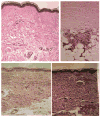Fibrosis in systemic sclerosis
- PMID: 18329536
- PMCID: PMC9904084
- DOI: 10.1016/j.rdc.2007.11.002
Fibrosis in systemic sclerosis
Abstract
This article reviews current understanding of the pathophysiology of fibrosis in systemic sclerosis. It highlights recent discoveries, insights, and emerging research, and potential opportunities for the development of targeted antifibrotic therapies.
Figures




References
-
- Kraling BM, Maul GG, Jimenez SA. Mononuclear cellular infiltrates in clinically involved skin from patients with systemic sclerosis of recent onset predominantly consist of monocytes/macrophages. Pathobiology. 1995;63(1):48–56. - PubMed
-
- Jelaska A, Korn JH. Role of apoptosis and transforming growth factor beta1 in fibroblast selection and activation in systemic sclerosis. Arthritis Rheum. 2000;43(10):2230–9. - PubMed
-
- Davies CA, Jeziorska M, Freemont AJ, et al. The differential expression of VEGF, VEGFR-2, and GLUT-1 proteins in disease subtypes of systemic sclerosis. Hum Pathol. 2006;37(2):190–7. [Epub 2005 Dec 15] - PubMed
-
- van der Slot AJ, Zuurmond AM, Bardoel AF, et al. Identification of PLOD2 as telopeptide lysyl hydroxylase, an important enzyme in fibrosis. J Biol Chem. 2003;278(42):40967–72. [Epub 2003 Jul 24] - PubMed
Publication types
MeSH terms
Substances
Grants and funding
LinkOut - more resources
Full Text Sources
Medical

